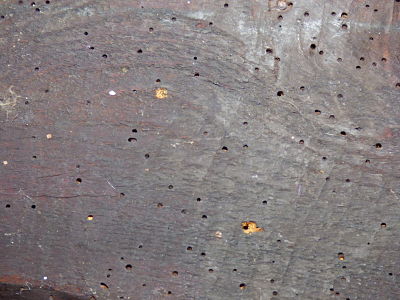
As the quality of timber used in buildings declined (from solid oak heartwood in the 17th Century to fast growing pine sapwood today) the incidence of Woodworm in buildings increased. The term Woodworm is given to one beetle - Anobium Punctatum also known as The Common Furniture beetle. Its presence has decreased in modern, centrally-heated buildings, but ground floor voids and roof spaces continue to be poorly ventilated and unheated, providing ideal conditions for the beetle to multiply. Woodworm attacks softwood and the sapwood of European hardwoods. Only very heavy infestations cause structural weakening.
Wood can be infected with eggs or larvae without it being noticeable, and you may not discover a woodworm infestation for several years. It's a common misconception that woodworm only affects old properties, in fact it can cause damage to newly constructed buildings.
The usual signs are: small round and clean holes with fine sawdust (frass). You may also see the beetles. Dirty and old holes are likely to indicate a previous infestation, probably dormant.
Adult beetles are responsible for boring the holes when they exit the wood to breed. This happens between May and September, so a good idea is to block the holes during the winter by painting with a coat of emulsion, or applying masking tape. In the spring, you can check if any beetles have emerged and therefore determine whether you have active woodworm in your timber.
Woodworm need a relatively high moisture content in the wood. At lower moisture levels, the rate of colonisation tends to be very low and the infestation will eventually die out. Relatively dry and well ventilated timber is at a much lower risk of infestation.
TreatmentsTimber that has been structurally weakened will have to be removed and replaced with pre-treated timber. Other affected woodwork will then need to be treated. Small-scale treatment can easily be carried out as a DIY job, but professional advice is recommended for the treatment of larger scale infestations and certainly for removal and replacement of large timbers.
A safe but effective treatment is borax, a compound of boron also known as sodium borate. This is available as a crystalline powder, which is dissolved as a 15% solution in water and applied to the affected timber. There are no health hazards associated with this treatment, and borax will inhibit fungal growth as well as killing woodworm.
While it's tempting to opt for a blanket treatment, this may not be the best choice. It's worth bearing in mind, for example, that treated timber is considered toxic waste at the end of its lifespan and must be disposed of accordingly. It is estimated that between 50,000 and 150,000 remedial timber treatments are carried out in British homes each year, many of which may be unnecessary.
 Further information is available at
Property Care
Further information is available at
Property Care